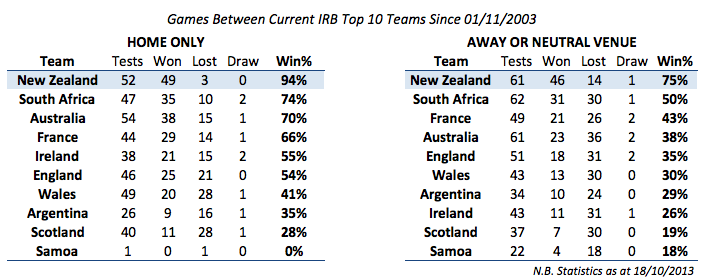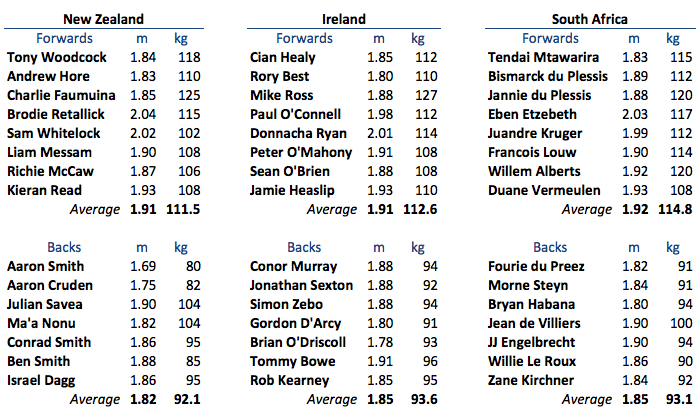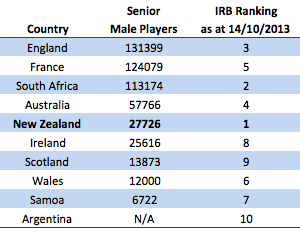Size Not Everything As All Blacks Show Their Strength
Originally published in the Irish Times Rugby Magazine, Wednesday Nov. 6th 2013: http://www.irishtimes.com/sport/rugby/international/size-not-everything-as-all-blacks-show-their-strength-1.1585659
Ireland have never beaten New Zealand in a test match, they of the haka and famed black kit. What makes the All Blacks different?
New Zealand’s record is nothing short of outstanding. In the last 10 years they’ve lost just three home tests while boasting a better record away from New Zealand than anyone else has managed at home. According to Betfair’s Barry Orr, it’s over three years since New Zealand went into a test match as an underdog.
“For me it’s their consistent execution of the basics”, said one current Irish international. A former international analyst put it like this: “They play in right part of the field and do their basics better. [It’s their] support play, passing, decision making and pace.”
Irish rugby has at times worried that their players are too small. South Africa are the current super-heavyweights of rugby union but they finished second to New Zealand in the Rugby Championshipdespite having a pack weighing over three kilos heavier per man.
New Zealand’s starting pack in the Rugby Championship decider weighed 892kg with an average height of 1.91m; their backs a total of 645kg at 1.82m. A reasonable punt at a probable Ireland autumn selection would see an Irish team weighing a kilo per man heavier than the All Blacks while being of slightly taller average height. The All Blacks are not giants, they’re just terrific at playing this game.
Kieran Read’s try in Ellis Park against South Africa in the Rugby Championship was a classic example of New Zealand playing simple, perfectly-executed rugby, as identified by analyst Scott Allen writing for Australian outlet The Roar.
Julian Savea and Kieran Read were attacking with just one defender, Willie Le Roux, between them and the tryline. The problem? There was so little space outside Savea that Read was actually running on the touchline. Read’s position as a forward is an irrelevance when discussing the All Blacks. “They have 15 ballplayers”, said Bernard Jackman, defence coach with Top 14 side Grenoble.
Savea adjusted his running line to come inside, drawing the defender, and a vital metre of space was opened up for Read on the outside to take the pass and score.
This simple draw and pass play is typical of New Zealand rugby. Conor McPhillips, Connacht’s performance analyst, said “they do the small, simple things consistently better than all other teams”.
Decision-making
On-field decision-making is a constant judgement of risk versus reward, continually asking the question “What is the best thing for me to do right now to ensure the optimal outcome for my team?”
That question is not one that can be consciously thought about in the heat of a test match. However, the process can be helped by finding as many answers as possible in advance. Where once having access to a video replay machine was the epitome of analytical sophistication rugby teams can now access swathes of data, usually bought from statistics houses like Opta.
Steve Cliffe, Opta’s man in Australia and New Zealand, said “New Zealand in general have access to the same information that other teams get from Opta but in my view there’s a difference in how they use the data.” He also said that in his opinion “New Zealand ask questions that others don’t”.
After the 2011 Rugby World Cup, New Zealand had come up with one of those questions. They asked Opta to measure ruck speed in international rugby, arranging this service in addition to the standard professional data offering. Recycling ball at pace is crucial as it reduces the time for a defence to get organised. In disorganisation lies opportunity, especially for tries.
Mark McDermott, RTÉ video analyst, said “New Zealand seldom have to overcommit at the breakdown. The first two or three arrive so fast and make it very difficult for their opponents”.
Ruck speed is measured manually by some international analysts but it’s intensive work. New Zealand reckoned that to get such data at scale it was more efficient to pay somebody else to do it.
While it’s relatively easy to pay for data, it takes an extra step to analyse it expertly and integrate the information gleaned into the team’s decision-making process. That’s where people like Ken Quarrie come in.
Performance analysis
Ken Quarrie is New Zealand Rugby’s senior scientist for injury prevention and performance. A graduate of Auckland University of Technology, he has published papers on everything from gumshields to scrum injuries. His team looks at player and team performance but also deals with “big picture” analysis and finding trends in the global game.
Quarrie’s work is judged to be highly sensitive by New Zealand; he’s their secret weapon, so to speak. Embracing such complexity allows New Zealand to develop insight into how the sport itself is changing.
The All Blacks won the 2012 Rugby Championship making the most carries with a try difference of +12. In 2013, they instead played a kicking game, putting boot to ball almost 20 per cent more then anyone else and spending plenty of time in defence.
New Zealand still scored the most tries in the tournament (24), conceded the fewest (10) and bettered their try difference from the previous season. This kicking strategy would not have happened by accident.
New Zealand’s rugby team has spent almost five years at the top of the IRB’s world rankings, the longest such streak ever.
It might be a while before it ends.
Note: teams included as presented for publication, i.e. before injuries to Zebo, etc.
Credits:
– Player heights and weights from allblacks.com, irishrugby.ie and sarugby.net
– 10 year match records from ESPN.com/SFMS Ltd.
– Senior player numbers courtesy of IRB.com



